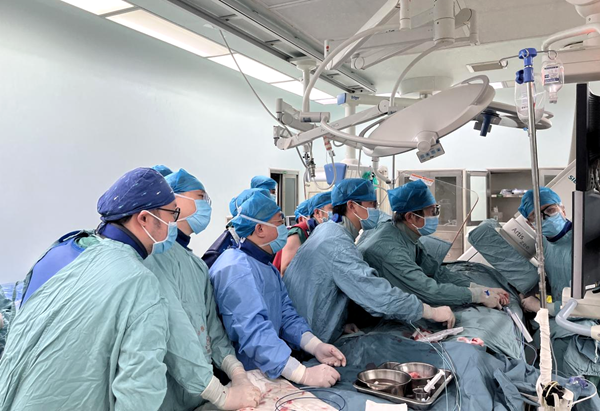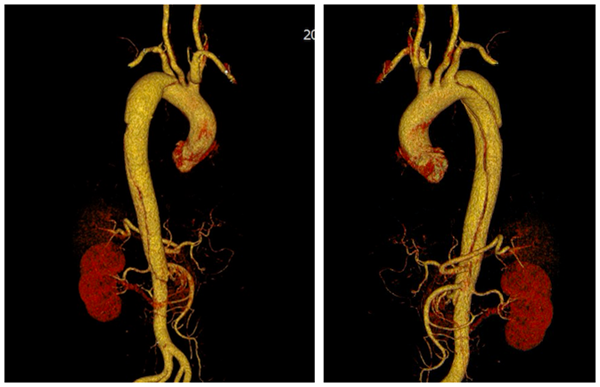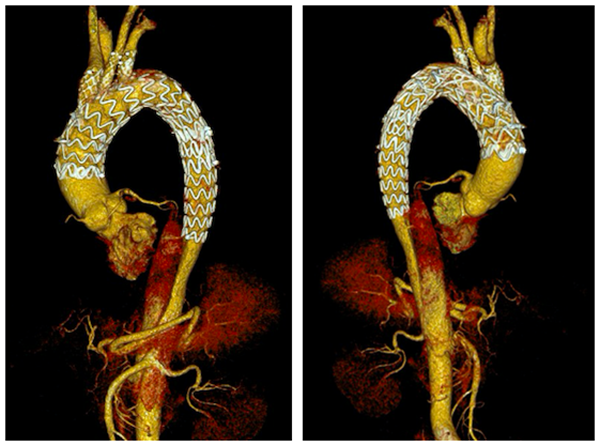Recently, the innovative three branch stent system (CS stent) for the aorta, created by China and with full intellectual property rights, successfully completed its first application in Stanford B-type aortic dissection at Xiangya Second Hospital of Central South University. This innovative stent system provides a new solution for the full lumen treatment of Stanford B-type aortic dissection lesions involving the aortic arch, greatly optimizing the brain protection strategy for full lumen repair of the aortic arch in design, and is expected to help more patients avoid the huge trauma of thoracotomy surgery and significantly improve their quality of life.

Mr. Yu is 66 years old this year. Due to sudden chest and back pain, he was transferred by ambulance 120 to the Department of Vascular Surgery at Xiangya Second Hospital of Central South University. After improving the aortic CT, it is indicated as a Stanford B-type aortic dissection, with the proximal tear located near the origin of the left common carotid artery. According to professional diagnostic and treatment guidelines and standards, this type of dissection is one of the most complex aortic dissection and is often considered a prohibited area for minimally invasive endovascular surgery, requiring thoracotomy. Due to Mr. Yu's advanced age and other complications, he was unable to tolerate the trauma of open chest surgery. Professor Shu Chang, a renowned doctor from Xiangya, led a vascular surgery team to carefully evaluate his condition and communicated fully with his family. Finally, he decided to use the CS aortic arch partial stent system with fully independent intellectual property rights to perform the surgery on Mr. Yu.
On April 2nd, with the joint assistance and cooperation of multiple disciplines such as the Anesthesiology Department, Cardiac Catheter Room, and Surgery Department, Professor Shu Chang led Professor Li Quanming, Professor He Hao, Professor Li Xin, Dr. Qiu Jian, and Dr. Liu Dingxiao to perform surgery on Mr. Yu. While isolating the rupture of the aortic dissection, the blood flow of the branch blood vessels supplying the brain was completely preserved. The surgery was successful, with an 87 minute interval between the first and last angiography during the surgery. Mr. Yu was able to move freely after removing the tracheal intubation on the day after surgery, and was able to move down to the ground on the second day after surgery. He was discharged smoothly on the eighth day after surgery.

The patient's preoperative aortic CTA examination revealed aortic dissection, which involved the left common carotid artery

The patient's postoperative aortic CTA reexamination showed good isolation of the proximal rupture of aortic dissection and unobstructed blood flow in some branches of the aortic arch
Aortic dissection is a critically ill condition with a high mortality rate. In recent years, endovascular technology has become the first choice for patients with Stanford B aortic dissection. For dissection involving the aortic arch, open surgery or hybrid surgery were often required in the past, often referred to as the forbidden zone for endovascular minimally invasive surgery. However, due to the characteristics of open surgery such as long surgical time, the need for extracorporeal circulation assistance, and significant trauma, it is difficult for some patient populations to obtain treatment opportunities. Professor Shu Chang led a vascular surgery team to focus on the pathological characteristics of aortic arch dissection and other aortic diseases. Through diligent research and ten years of hard work, he ultimately designed an integrated three branch stent system with fully independent intellectual property rights. Its unique groove mesh structure can provide good support without affecting brain blood supply, thereby reducing the occurrence of cerebral ischemia, In 2014, the patent layout was further improved, and in September 2022, the first integrated three branch stent treatment for aortic arch aneurysms in China was completed at Xiangya Second Hospital. Subsequently, three cases of integrated three branch stent treatment for aortic arch aneurysms were successfully completed at Fuwai Hospital of the Chinese Academy of Medical Sciences. This was the first time it was applied in aortic dissection, further confirming the effectiveness and safety of the stent system, It is expected to benefit more patients with complex aortic arch lesions.
Minimally invasive treatment for aortic arch lesions is actually being developed in Europe, the United States, and Asian countries including China to simplify surgical procedures and reduce the risk of trauma and complications for patients. Due to its large curved side groove mesh design, the CS stent has become the first three branch stent system in the world that does not affect brain blood supply during arch branch reconstruction. The surgery completed this time is also the first application of this design concept in patients with Stanford B-type aortic dissection. Under the leadership of Professor Shu Chang, the Department of Vascular Surgery at Xiangya Second Hospital of Central South University will continue to closely follow the international cutting-edge treatment technologies and concepts of vascular surgical diseases, focus on the transformation of scientific research achievements into clinical practice, and make positive contributions to the people's health cause.


